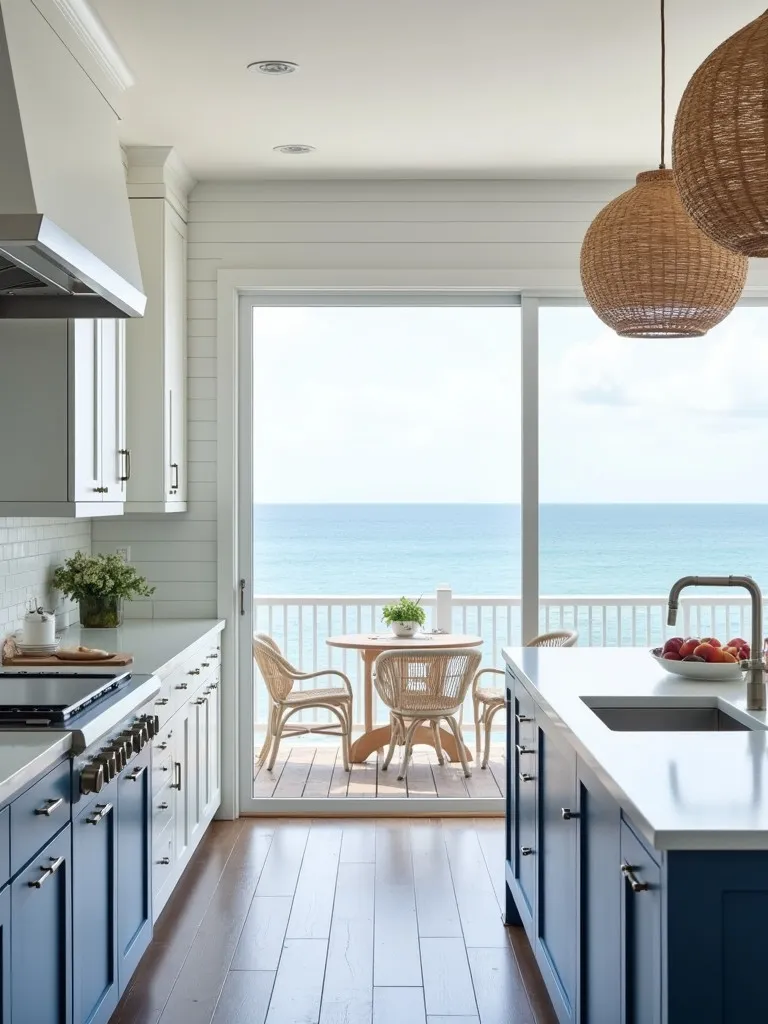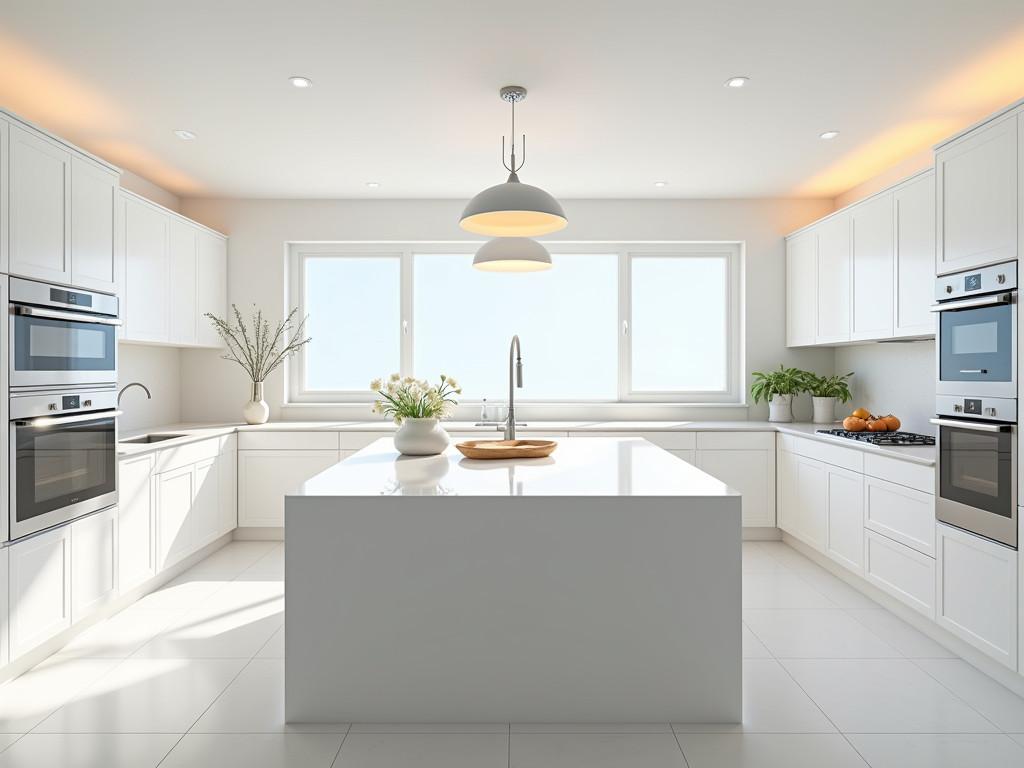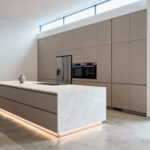Hey there, fellow design enthusiasts! Jasmine here, ready to shed some light on one of my favorite topics: lighting for white kitchens. You know, a white kitchen is like a blank canvas, just waiting for you to splash it with personality. And what better way to do that than with some killer lighting? Whether you’re whipping up a gourmet feast or just grabbing a midnight snack, the right lighting can transform your space from clinical to cozy in an instant.
So, grab a cup of coffee (or a glass of wine, I won’t judge), and let’s dive into the world of illuminating your culinary haven. Trust me, by the time we’re done, you’ll be itching to give your white kitchen a luminous makeover. And hey, if you’re still in the dreaming phase, check out these ideas for your dream white kitchen for some extra inspiration!

Key Takeaways
Alright, before we dive deep into the world of lumens and LEDs, let’s break down the essentials:
- Lighting for white kitchens isn’t just about brightness – it’s about creating a vibe that makes you want to linger over that morning coffee or dance while doing the dishes.
- Mix it up! Combine ambient, task, and accent lighting for a space that’s as functional as it is fabulous.
- Choose fixtures that complement your kitchen’s style. Think sleek pendants over islands or under-cabinet strips that make your countertops glow.
- Dimmers are your BFFs. They let you switch from bright and energizing to soft and romantic faster than you can say “mood lighting.”
- Color temperature matters! Warm lights can make your space feel cozy, while cooler tones give it a modern edge.
- Go green with energy-efficient options. Your wallet (and Mother Earth) will thank you!
Importance of Lighting
Let’s face it, folks – lighting for white kitchens is like the secret sauce in your grandma’s famous recipe. It’s the thing that brings everything together and makes it pop. So, why is it so crucial? Let me break it down for you.

Enhance Kitchen Aesthetics
Picture this: you’ve got this gorgeous white kitchen with all the bells and whistles. But without the right lighting, it’s like wearing a designer gown with scuffed-up sneakers. Good lighting is the perfect accessory for your space. It highlights those sleek cabinet lines, makes your countertops gleam, and turns your kitchen from “meh” to “marvelous.” Plus, with the right fixtures, you’re adding another layer of style to your already fabulous space. It’s like jewelry for your kitchen!
Improve Functionality
Now, let’s get practical for a second. Do you know those cooking shows where the chef effortlessly dices onions at lightning speed? Well, part of that magic is good lighting. (The other part is years of practice, but we’ll focus on the lights for now.) Proper lighting for white kitchens isn’t just about looking good – it’s about seeing good. Task lighting over your prep areas means you can chop, dice, and julienne without fear of losing a finger. And let’s be real, being able to read that recipe without squinting is a game-changer.
Influence Mood and Ambiance
Here’s where lighting gets fun. With the right setup, you can transform your kitchen from a bright, energizing space for your morning coffee rush to a cozy nook for late-night ice cream sessions. Dimmable lights are like having a magic wand – you can set the mood for everything from family breakfasts to romantic dinners. And in a white kitchen? The effect is amplified. Your space becomes a chameleon, changing with your needs and whims. How cool is that?

Types of Lighting
Alright, DIY lighting designers, let’s talk about the different types of lighting that’ll make your white kitchen shine (literally). Think of these as the ingredients in your perfect lighting recipe.
Ambient Light Options
Ambient lighting is like the base of your favorite soup – it sets the tone for everything else. In a white kitchen, it’s crucial to create that overall glow that makes the space feel warm and inviting. Here are some options to consider:
- Ceiling-mounted fixtures: These bad boys spread light evenly across your kitchen. Think flush mounts or semi-flush mounts that don’t hang too low.
- Recessed lights: Perfect for that sleek, modern look. They’re like little spotlights embedded in your ceiling.
- Chandeliers: Who says kitchens can’t be glamorous? A statement chandelier can be the crown jewel of your white kitchen.
Pro tip: When choosing the right flooring for a white kitchen, consider how it’ll reflect your ambient lighting. A glossy floor can amplify the light, while a matte finish might absorb it.

Task Lighting Essentials
Now, let’s get down to business. Task lighting is all about functionality – it’s the spotlight on your culinary stage. In a white kitchen, it’s especially important to have focused light to contrast with all that brightness. Here’s what you need:
- Under-cabinet lights: These are non-negotiable, folks. They illuminate your countertops, making food prep a breeze.
- Pendant lights: Hang these over islands or sinks for both style and substance.
- Adjustable spotlights: Perfect for targeting specific areas that need extra illumination.
Remember, in a white kitchen, task lighting isn’t just practical – it adds depth and dimension to your space.
Accent Lighting Ideas
This is where we add the pizzazz! Accent lighting is like the garnish on your perfectly plated dish – it’s what makes people go “ooh” and “aah.” In a white kitchen, accent lighting can create stunning contrasts and highlight your favorite features. Try these:
- LED strip lights: Tuck these under floating shelves or along the kickboards of your cabinets for a modern glow.
- Spotlights: Use these to showcase artwork or that fancy espresso machine you splurged on.
- Glass-front cabinet lighting: Illuminate your prettiest dishes and make them part of your decor.

The key with accent lighting in a white kitchen is subtlety. You want to create points of interest without overwhelming the clean, bright aesthetic.
Creating Layered Lighting
Okay, design enthusiasts, now we’re getting to the good stuff. Layered lighting is where the magic happens in any space, but especially in a white kitchen. It’s all about combining different types of light to create depth, interest, and functionality. Let’s break it down!
Layering Techniques
Think of layering your lighting for white kitchens like crafting the perfect outfit. You’ve got your base layer (ambient), your practical pieces (task), and your accessories (accent). Here’s how to put it all together:
- Start with your ambient lighting as the foundation. This could be recessed lights or a central fixture that provides overall illumination.
- Add task lighting in key areas – over the countertops, sink, and island. This ensures you can see what you’re doing when you’re channeling your inner Master Chef.
- Finish with accent lighting to highlight architectural features or decor elements. This is where you can let your personality shine!

Pro tip: When maximizing space in a small white kitchen, clever lighting can make your room feel larger. Use uplighting to draw the eye upward and create the illusion of height.
Balancing Light Levels
Balancing light in a white kitchen is like conducting an orchestra – every element needs to play its part without overpowering the others. Here’s how to achieve harmony:
- Use dimmers on all your lights. This allows you to adjust the intensity based on the time of day or activity.
- Consider the natural light in your space. If you have large windows, you might need less ambient lighting during the day.
- Aim for a mix of light temperatures. Combine cool whites for task areas with warmer tones for ambient lighting to create a welcoming atmosphere.
Remember, in a white kitchen, too much light can be as problematic as too little. You want to create contrast and depth, not a blinding glare.

Integrating Different Sources
Mixing light sources in your white kitchen is like creating a perfect playlist – each element should complement the others. Here’s how to nail the mix:
- Combine ceiling lights, pendants, and under-cabinet lighting for a well-rounded scheme.
- Use a mix of fixture styles to add visual interest. A modern pendant can look amazing alongside more traditional sconces.
- Don’t forget about portable lamps! A small lamp on a countertop can add a cozy touch and give you flexibility.
The key is to ensure each light source serves a purpose and contributes to the overall ambiance of your white kitchen.
Choosing Fixtures and Placement
Alright, my fellow design enthusiasts, now come the fun part – choosing the actual fixtures for your white kitchen! This is where you get to flex those creative muscles and make your space shine (pun intended).

Selecting Right Fixtures
Choosing fixtures for a white kitchen is like picking the perfect accessories for your favorite outfit. You want pieces that complement the space without overwhelming it. Here are some tips:
- Consider your kitchen’s style. Is it modern? Traditional? Farmhouse chic? Choose fixtures that vibe with your overall aesthetic.
- Think about scale. In a small kitchen, delicate pendants might work best, while a larger space can handle a more substantial chandelier.
- Don’t be afraid of contrast! Black or metallic fixtures can create stunning focal points in a white kitchen.
- Look for fixtures with interesting textures or materials. Glass, metal, or even woven elements can add depth to your space.
Remember, your lighting fixtures are like jewelry for your kitchen. They should enhance the beauty of your white canvas, not compete with it.

Ideal Fixture Placement
Now that you’ve picked out your gorgeous fixtures, let’s talk about where to put them. Proper placement is key to achieving that perfect lighting for the white kitchens we’re after. Here’s a quick guide:
- Over the island: Hang pendants about 30-36 inches above the countertop. This provides task lighting and creates a beautiful focal point.
- Above the sink: A single pendant or small chandelier can add both function and style to this hardworking area.
- Over dining areas: If you have an eat-in kitchen, center a statement fixture over the table. It’ll define the space and create an ambiance for meals.
- Under cabinets: Install strip lighting to illuminate countertops and eliminate shadows.
Pro tip: In a white kitchen, shadows can be particularly noticeable. Make sure you have enough overlapping light sources to minimize harsh shadows.

Optimal Spacing Guidelines
Spacing your lights correctly is like following a recipe – get it right, and the result is perfection. Here are some guidelines to keep in mind:
- For recessed lights: A general rule is to space them about 24 inches apart. In a white kitchen, you might want to go a bit closer to ensure even illumination.
- For pendant lights: If you’re hanging multiple pendants, space them about 30 inches apart, center to center.
- For under-cabinet lighting: Install strips about 3 inches from the front of the cabinet to avoid glare on shiny countertops.
Remember, these are guidelines, not hard and fast rules. Always consider the specific needs of your space and don’t be afraid to adjust as needed.
Tips for Fixture Selection
Alright, design aficionados, let’s dive into the nitty-gritty of choosing those perfect fixtures for your white kitchen. This is where we get to have some fun and let your personality shine through!

Pendant Light Choices
Pendant lights are like the statement necklaces of kitchen design – they can make or break your look. When it comes to lighting for white kitchens, pendants are your chance to add a pop of color or an interesting shape. Here are some ideas to get you started:
- Go for contrast: Black or dark metal pendants can create a striking look against a white backdrop.
- Play with shapes: Geometric pendants add a modern touch, while globe shapes offer a softer, more classic feel.
- Consider glass: Clear or frosted glass pendants can add light without visually cluttering the space.
- Mix and match: Try hanging pendants of different lengths for a playful, eclectic vibe.
Remember, the key is to choose pendants that complement your kitchen’s style while providing the right amount of light for your needs.
Under Cabinet Solutions
Under cabinet lighting is like the secret weapon in your kitchen lighting arsenal. It’s practical, yes, but it can also add a gorgeous glow to your white kitchen. Here’s what to consider:
- LED strips: These are my go-to for under-cabinet lighting. They’re energy-efficient, slim, and can often be customized to your exact cabinet length.
- Puck lights: These round lights are great for creating pools of light on your countertop. They work well in kitchens with fewer cabinets.
- Color temperature: In a white kitchen, I love using warm white lights (around 3000K) under cabinets. It adds a cozy feel without yellowing the white surfaces.

Pro tip: If you’re feeling fancy, look into smart LED strips that can change color. They’re perfect for setting the mood for everything from intense cooking sessions to late-night snack raids!
Recessed Light Tips
Recessed lights are like the backup singers of your kitchen – they might not be the stars of the show, but your lighting scheme wouldn’t be complete without them. Here’s how to nail the recessed lighting in your white kitchen:
- Size matters: In most kitchens, 4-inch or 5-inch recessed lights work well. They provide plenty of light without looking too chunky.
- Placement is key: Focus on areas that need good general lighting, like walkways and in front of appliances.
- Consider adjustable trims: These allow you to direct the light where you need it most, which can be super helpful in a white kitchen where you want to avoid harsh shadows.
- Don’t overdo it: In a white kitchen, you might need fewer recessed lights than you think. Start with a basic plan and add more only if necessary.
Remember, the goal with recessed lighting is to create even, ambient light that complements your other fixtures. In a white kitchen, this helps maintain that bright, airy feel we’re all after.

Using Dimmers and Controls
Okay, lighting lovers, now we’re getting to the really fun stuff – playing with dimmers and controls! This is where your white kitchen lighting goes from “nice” to “OMG, I love spending time in here!” Let’s dive in.
Benefits of Dimmers
Dimmers are like the magic wands of lighting for white kitchens. They give you the power to transform your space with just a flick of your wrist (or a tap on your smartphone). Here’s why I’m obsessed with dimmers:
- Mood master: Want bright light for chopping veggies? Crank it up! Craving a cozy vibe for a late-night snack? Dim it down. Dimmers let you set the perfect atmosphere for any occasion.
- Energy saver: By using less electricity when you don’t need full brightness, you’re being kind to both your wallet and the planet. Win-win!
- Bulb life extender: Dimming your lights can make your bulbs last longer. It’s like a spa day for your light fixtures!
- Glare reducer: In a white kitchen, glare can sometimes be an issue. Dimmers let you find that sweet spot where everything is visible without being harsh on the eyes.
Pro tip: Install dimmers on all your main light sources – overheads, pendants, and even under-cabinet lights. You’ll thank me later!

Control Options
Now, let’s talk about how to control all this fabulous lighting. We’ve come a long way from the basic wall switch, folks. Here are some options to consider:
- Smart switches: These babies let you control your lights from your phone. Did you forget to turn off the kitchen light? No problem – just tap your app!
- Voice control: Integrate your lighting with smart home systems like Alexa or Google Home. “Hey Google, dim the kitchen lights for movie night” – how cool is that?
- Scene settings: Some advanced systems let you program “scenes” – like “Cooking,” “Dining,” or “Clean-up” – that adjust multiple lights at once.
- Motion sensors: Great for pantries or under-cabinet lights. They turn on when you need them and off when you don’t.
Remember, the best control system is one that you’ll use. If you’re not super tech-savvy, there’s nothing wrong with good old-fashioned dimmer switches. The goal is to make your white kitchen lighting work for you, not the other way around.
Light Color and Temperature
Alright, color enthusiasts, let’s talk about one of my favorite subjects – the color of light! In a white kitchen, the color temperature of your lighting can make a huge difference in how the space feels. It’s like choosing the perfect filter for your Instagram photo – get it right, and everything looks amazing. Get it wrong, and, well… let’s just say it’s not #instaworthy.

Choosing Color Temperature
When it comes to lighting for white kitchens, color temperature is key. Here’s the lowdown:
- Warm white (2700K-3000K): This cozy, slightly yellow light is perfect for creating a welcoming vibe. It’s great for eating areas or if you want your kitchen to feel like a warm hug.
- Neutral white (3500K-4000K): The Goldilocks of light temperatures – not too warm, not too cool. It’s perfect for task lighting and general illumination in your white kitchen.
- Cool white (5000K-6500K): This crisp, slightly blue light is energizing and great for task areas. But be careful – too much cool light can make your white kitchen feel a bit clinical.
Pro tip: Mix and match! Use cooler lights for task areas and warmer lights for ambient lighting. This creates depth and interest in your white kitchen.
Matching Kitchen Style
The color temperature you choose should vibe with your kitchen’s overall style. Here’s a quick guide:
- Modern kitchens: Lean towards cooler temperatures for that sleek, contemporary feel.
- Traditional kitchens: Warmer lights complement classic designs beautifully.
- Farmhouse style: Stick with warm to neutral whites for that cozy, homey atmosphere.

Remember, lighting for white kitchens is all about enhancing the space. The right color temperature can make your cabinets pop, your countertops gleam and your whole kitchen sing!
Energy-Efficient Lighting Options
Let’s face it, folks – we all want to save some green while going green. When it comes to lighting for white kitchens, energy efficiency is the name of the game. It’s like getting a two-for-one deal: you save on your energy bills AND help Mother Earth. How’s that for a win-win?
LED Light Benefits
LED lights are like the superheroes of the lighting world. Here’s why I’m obsessed with them for white kitchens:
- Long-lasting: These bad boys can last up to 25,000 hours. That’s like, forever in light bulb years!
- Energy-efficient: LEDs use up to 75% less energy than traditional bulbs. Your wallet will thank you.
- Versatile: They come in all shapes, sizes, and color temperatures. Perfect for creating that layered lighting we talked about earlier.
- No heat: Unlike some other bulbs, LEDs don’t get hot. This means they’re safer and won’t heat your kitchen when you’re already sweating over the stove.

Pro tip: Look for LED bulbs with high CRI (Color Rendering Index). This ensures colors in your white kitchen look true and vibrant.
Energy-Saving Tips
Want to take your energy-saving game to the next level? Here are some of my favorite tricks:
- Use natural light: Position workspaces near windows to take advantage of daylight.
- Install motion sensors: Great for pantries or less-used areas of your kitchen.
- Choose ENERGY STAR-certified fixtures: These are guaranteed to be energy-efficient.
- Clean your fixtures regularly: Dust can reduce light output, making you think you need brighter (and more energy-consuming) bulbs.
Remember, energy-efficient lighting for white kitchens isn’t just about the bulbs – it’s about how you use them. Be smart, and you’ll be saving in no time!
Final Remarks
Whew! We’ve covered a lot of ground, haven’t we? From ambient lighting to energy-efficient options, we’ve explored all the ways you can make your white kitchen shine (literally and figuratively).

Here’s the thing about lighting for white kitchens – it’s not just about illumination. It’s about creating a space that feels like home. A place where you want to linger over your morning coffee, where friends gather for impromptu wine nights, and where your family creates memories over home-cooked meals.
So, as you embark on your kitchen lighting adventure, remember:
- Layer your lighting for depth and functionality.
- Choose fixtures that reflect your style.
- Don’t be afraid to play with color temperature.
- Embrace energy-efficient options.
- And most importantly, have fun with it!
Your white kitchen is a blank canvas, and lighting is your paint. So go forth and create your masterpiece! And hey, if you need more inspiration or want to show off your newly lit kitchen, you know where to find me. Happy designing, light lovers!






